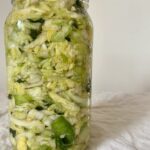
Stinging nettle sauerkraut with leeks and lemon
This sauerkraut with nettles is bright, earthy, and pleasantly grassy. It's a warm welcome for spring and sunny days ahead.
Equipment
- 1 gallon canning jar or ceramic crock
- Fermentation weight
Ingredients
- 4 lbs green cabbage
- 2 large leeks
- 6 cloves garlic white and red Can substitute with Leeks or Shallots
- 4 oz fresh stinging nettle
- 3-4 tbsp unrefined sea salt
Instructions
Day 1
- Wash all your vegetables, bus tub, and fermentation container(s).
- Chop the cabbage, leeks, and garlic. Zest the lemon. Pluck the stinging nettle leaves from the stems. Put the cabbage, leeks, and garlic into the bus tub and add sea salt.
- Massage the salt in with your hands for a couple of minutes. Set aside for 30-60 minutes. Mix in the lemon zest, juice, and stinging nettle leaves.
- Pack the sauerkraut mixture, including the liquid that has been released, into a jar or crock. Firmly pack down the cabbage mixture and place your weight.
- Let it ferment in a cool spot away from direct sunlight.
Day 2
- Check the brine. It may have increased overnight. If it does, pour off extra brine so that it doesn’t overflow. Check it again later in the day to make sure the brine didn’t rise back up. Pour off any extra.
- Give it a visual check every day.
Day 3
- Expect to see bubbles rising up through the brine and maybe foam on top.
- Give it a visual check every few days.
Day 7-21
- You may notice less activity and no foam or bubbles. This is normal!
- Give it a try to see how you like it. More time = more tang. If you want it to keep fermenting longer, place everything back under the brine and keep it at room temp for a few more days.
Storage
- Once fermented to your liking, put a label on the jar with the name and date of your ferment. Top the jar with a plastic lid and place it in the fridge.
Notes
Skip the lemon. This will keep the kraut more savory, bringing out the flavor of the leeks and garlic.
Use a fermentation weight. These sit right on top of the vegetables to keep them underneath the brine. They’re a simple and non-toxic way to do fermentation at home. You could also use a fermentation device, like Kraut Source.
Ferment in a ceramic crock. These are best for big batches and families.
Watch for signs of fermentation. This usually starts on day 2 and peaks on day 3. You might see foam at the top or bubbles rippling through the brine. This is a good sign! It means healthy bacteria are there doing their job.
Save the brine! For a potent probiotic punch, sip the brine with lunch or use it to replace the vinegar in your favorite salad dressing.